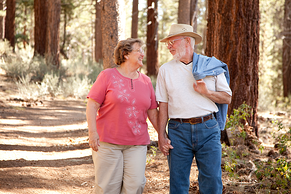This blog was written by Anna Hiple. Meet our blogging fitness specialists at the NIFS website.
 Walking has long been touted as one of the most effective forms of aerobic exercise an individual can perform. The convenience of walking and the relative ease of it (compared to some other forms of high-impact exercise) make it a beneficial part of any exercise program for individuals of all ages.
Walking has long been touted as one of the most effective forms of aerobic exercise an individual can perform. The convenience of walking and the relative ease of it (compared to some other forms of high-impact exercise) make it a beneficial part of any exercise program for individuals of all ages.
The Impact of Walking on Senior Health
Regular walking is especially important for seniors, as it helps them maintain balance, muscle mass, and cardiovascular function that can otherwise deteriorate with age. It assists with the prevention of chronic disease and may help ease the symptoms of some medical conditions.
In addition, what’s good for the body has also been proven to be good for the mind; walking combats age-related cognitive decline, which helps seniors maintain their memory and prevent dementia. Specifically, walking increases the size of the hippocampus, which is a section of the brain related to memory.
Studies Prove the Memory Benefits of Walking for Senior Wellness
While many forms of activity can be good for the brain, a year-long study at a handful of universities specifically highlights the benefits of walking as compared to other forms of activity. Data was taken from two groups of seniors: one group with a walking program and another performing yoga and resistance-band training. The size of the hippocampus increased in the walking group but decreased in the other group. Therefore, especially if you are a senior, it’s important to lace up those athletic shoes and hit the pavement!
Walking Tips for Seniors
Check out the following walking tips for seniors:
- If you’re just beginning, start slow. You may want to consult with your doctor about a program.
- Walk as briskly as possible, which will help you reap the most benefits.
- Invest in a pair of comfortable walking/running shoes with plenty of support and cushioning.
- If you have joint ailments, try finding softer ground on which to walk, such as a trail or a track.
- Incorporate intervals into your walking program. Mix in speed bursts and incline training.
- Recruit a walking buddy. Exercise can be much more enjoyable with a friend!
- If walking outside, try varying your routes to keep the scenery interesting.
